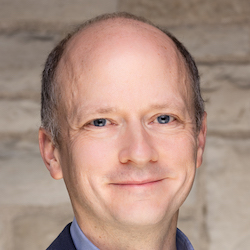Protecting the Body’s Joints Via the Central Nervous System
Northwestern Engineering research offers new understanding of the role of the central nervous system in protecting joints
From soccer players making aggressive change-of-direction cuts on the pitch to daily tasks like walking up stairs, muscle activation is a part of everyday life for humans. Yet during such movements, the body’s joints face the very real risk of encountering pain, injury, or osteoarthritis.
A Northwestern Engineering research team led by Professor Matthew Tresch has found that when it comes to preventing potentially excessive stress within the body’s joints, the central nervous system is an active player mindful of the body’s well-being. The findings, published in September in the open-source scientific journal eLife, have the potential to influence injury rehabilitation and help unlock even bigger mysteries related to the body’s neurocircuitry.
 “Our study provides evidence that the nervous system chooses muscle activations to avoid joint injury, which is something that hasn’t been so clearly demonstrated before and opens the door to exciting future experimentation,” said Tresch, associate professor of biomedical engineering at Northwestern’s McCormick School of Engineering.
“Our study provides evidence that the nervous system chooses muscle activations to avoid joint injury, which is something that hasn’t been so clearly demonstrated before and opens the door to exciting future experimentation,” said Tresch, associate professor of biomedical engineering at Northwestern’s McCormick School of Engineering.
Tresch co-authored the paper with Northwestern physiology postdoctoral fellow Cristiano Alessandro, former physiology postdoc Filipe Oliveira Barroso, now of the Spanish National Research Council, and Benjamin Rellinger (PhD ’13), whose biomedical engineering PhD thesis work under Tresch produced much of the study’s pilot research. Tresch, whose lab is located in the Northwestern’s Department of Physiology at Northwestern University Feinberg School of Medicine, also holds a dual appointment as associate professor of physical medicine and rehabilitation.
While the importance of the forces within a joint has long been obvious to clinicians and researchers studying sports injuries and rehabilitation, the neural control of such forces has historically been underappreciated.
Given his background in basic neuroscience and neurophysiology as well as his affiliation with the Shirley Ryan AbilityLab, Tresch was compelled to examine the central nervous system’s relationship to muscle activation and joint health.
“We wanted to explore the role the central nervous system plays in determining better ways to activate muscles and, specifically, if the nervous system chooses the activation that avoids injury,” Tresch explained.
The group’s experiment in rats produced clear results that the central nervous system is engaged in preventing potentially excessive stress and strain within the joints.
“Intuitively, this made sense to a lot of people, but it wasn’t something obvious and it hadn’t been clearly demonstrated before,” Tresch said.
While Tresch acknowledges that specific prescriptions about clinical care remain distant, his team’s work demonstrates the importance of internal joint variables in motor control, particularly the neural systems underlying the control of these variables as well as their impact to rehabilitation strategies.
When individuals have a stroke or rupture an ACL, for instance, the common clinical perspective is to train them back to their pre-injury behavior, such as pushing them to walk or throw just as they did before the injury. Rehabilitation, therefore, is focused on the restoration of healthy task performance with minimal consideration usually given to the restoration of healthy internal joint stresses or strains.
“The fact of the matter is that the nervous system is paying attention, which means we need to expand what we think about when it comes to movement, muscle activation, and rehabilitation,” Tresch said. “We need to consider how the nervous system and muscles work together, because in the aftermath of an injury, we can’t necessarily replicate what we did in the past.”
These findings set up future experimentation to investigate neural circuitry underlying the control of joints, which can stimulate a richer understanding about the relationship between neural controls and specific parts of the body, he added.
“Understanding that the nervous system is actively involved here, we can take some important next steps,” Tresch said. “We can go after questions about neural control and neurocircuitry more systematically, which can lead to some impactful findings for improving physiological movement.”
This research was supported by grant number NS086973 from the National Institute of Neurological Disorders and Stroke of the National Institutes of Health.